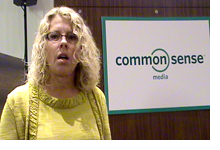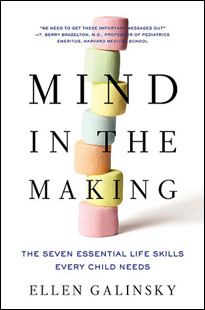Wednesday, November 2nd, 2011
[The following is an article I wrote for the November 2011 issue of Children’s Technology Review.]
This last month was a big one for new research unveiled about kids and media use, a least in terms of Google new alerts. Here’s a look beyond the headlines.
Event #1: The AAP Position Statement

In mid-October the American Academy of Pediatrics (AAP) made a statement regarding media use for young children ages 0 to 2 years of age at the AAP National Conference held in Boston. Media research fans may remember the AAP released a position statement over a decade ago stating screened media use for children ages 0 to 2 should be avoided entirely because there is no proof that television can be of educational value to children at such an early age. Fast forward to last month and the policy statement is pretty much the same. TV at this early age is still not educational. But hasn’t the media delivery landscape evolved from passive to interactive? What about all of those iPhones, iPads, tablets and other mobile devices? Should young children avoid using these devices as well? The AAP was much more presentation savvy with their announcement this time around, however. They acknowledged in their press announcement that the realities of being a parent with a young child mean that sometimes a television is used to pacify a child so the parent can take a shower or cook dinner. The AAP acknowledges that screen use is almost at two hours a day for some the youngest media consumers. However, the AAP could not make any recommendations related to interactive media. While there is a mountain of research available related to linear video viewing, there just aren’t many studies available regarding interactive screen use, for any age group.
Event #2: Zero to Eight: Children’s Media Use in America

Exactly one week after that AAP press event Common Sense Media held its own media event in Washington DC: a survey of families regarding the use of media with children 0 to 8 years of age. This time, the survey considered interactive media useage. You may recall that Vicky Rideout used to work with the Kaiser Family Foundation, and was a lead researcher on a series of studies related to children, media use, and health. She coordinated three 5-year surveys of media use across a wide range of platforms, ages, ethnicities and socio-economic groups. When Vicky announced in March, 2010 that she would be moving on from Kaiser, the media research space collectively wondered “Would we ever see another five year media study again?†Thankfully we recently found out the answer was a resounding yes! Not only did this new report cover areas of concern by the AAP, but it also provided great insight into the iPad/iPhone/mobile and interactive screened media world for kids. One of the most shocking data points in this study was the percentage of televisions found in a child’s bedroom. 30% of all children age 0 to 1, 44% of all children ages 2 to 4, and 47% of children ages 5 to 8 have a television in their bedroom! The scariest part of this data is these numbers are just averages. When you tease out percentages for ethnic groups and low-income families these numbers rise, and by a lot!
Another surprising data point was the percentage of children that have used interactive devices like the iPad. That number is only 7%. A handful of people have asked me, “Is that right?” First, this number is an average across all ages and as you slice the data the percentages rise as a child ages and lower for younger children. Again, this percentage drops significantly with ethnic groups and low-income families. What we also learn from this number is that television is a primary source of educational content for non-white and lower income families. The question I ask an eager iPad development community “Are we creating apps in an attempt to provide really great learning opportunities for all children when the reality is only a small sliver of economically advantaged children actually benefit from our apps?” Another surprising number, among the poorest households 38% of respondents didn’t know what an “app” was. This paper describes a new trend referred to the “app gap.†Those of us working in the children’s software space have long theorized that kids are spending more time with interactive media, games, handhelds and iPads and less time watching television. This latest report says no, television is still very much the leading device, alive and well more than we ever could have imagined. But wait, that’s a research slice in time that has already passed! In conversations with Vicky she suggests that the world of screened media for kids, be it interactive or passive, is changing very fast. Reports she was part of that came out every five years are not able to accurately capture the incremental changes in the children’s technology space. Thankfully additional reports may be on the horizon in two, probably three more years says Vicky.
So what are the main take-aways? Television is still very prominent in the lives of children ages 0 to 8. Just three years ago researchers were not aware of the influence the app concept would have in the children’s media space. Apps didn’t exist. Change is happening, but not equally for all children. Television still remains the best way to reach young children with educational content, especially children in socio-economically disadvantaged homes. However, there is now no doubt that interactive media is changing the media landscape.
Referenced research links:
- AAP Policy Statement
Media Use by Children Younger than 2 Years
Also this link - Common Sense Media
Zero to Eight: Children’s Media Use in America - Northwestern University
Media Use Among White, Black, Hispanic and Asian American Children (an update to the 2010 Kaiser Family Foundation children’s Media Use Report)
Also this link - Kaiser Family Foundation
Generation M2: Media in the Lives of 8- to 18-Year-Olds - Kaiser Family Foundation
Study Shows How Kids’ Media Use Helps Parents Cope - Kaiser Family Foundation
Generation M: Media in the Lives of 8-18 Year-olds - Kaiser Family Foundation
Kids & Media @ The New Millennium - Vicky Rideout interview
Zero to Eight Children’s Media Use Research Overview (video) - Vicky Rideout Presentation of 0 to 8 Report (video)
- AAP policy statement for the press (video)


 These are just the few of the questions posed to readers in
These are just the few of the questions posed to readers in 

